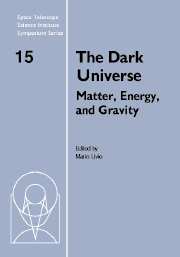Book contents
- Frontmatter
- Contents
- Participants
- Preface
- A brief history of dark matter
- Microlensing towards the Magellanic Clouds: Nature of the lenses and implications on dark matter
- Searching for the Galactic dark matter
- Hot gas in clusters of galaxies and ΩM
- Tracking the baryon density from the Big Bang to the present
- Modified Newtonian Dynamics and its implications
- Cosmological parameters and quintessence from radio galaxies
- The mass density of the Universe
- Growth of structure in the Universe
- Cosmological implications of the most distant supernova (known)
- Dynamical probes of the Halo Mass Function
- Detection of gravitational waves from inflation
- Cosmological constant problems and their solutions
- Dark matter and dark energy: A physicist's perspective
Detection of gravitational waves from inflation
Published online by Cambridge University Press: 21 August 2009
- Frontmatter
- Contents
- Participants
- Preface
- A brief history of dark matter
- Microlensing towards the Magellanic Clouds: Nature of the lenses and implications on dark matter
- Searching for the Galactic dark matter
- Hot gas in clusters of galaxies and ΩM
- Tracking the baryon density from the Big Bang to the present
- Modified Newtonian Dynamics and its implications
- Cosmological parameters and quintessence from radio galaxies
- The mass density of the Universe
- Growth of structure in the Universe
- Cosmological implications of the most distant supernova (known)
- Dynamical probes of the Halo Mass Function
- Detection of gravitational waves from inflation
- Cosmological constant problems and their solutions
- Dark matter and dark energy: A physicist's perspective
Summary
Recent measurements of temperature fluctuations in the cosmic microwave background (CMB) indicate that the Universe is flat and that large-scale structure grew via gravitational infall from primordial adiabatic perturbations. Both of these observations seem to indicate that we are on the right track with inflation. But what is the new physics responsible for inflation? This question can be answered with observations of the polarization of the CMB. Inflation predicts robustly the existence of a stochastic background of cosmological gravitational waves with an amplitude proportional to the square of the energy scale of inflation. This gravitational-wave background induces a unique signature in the polarization of the CMB. If inflation took place at an energy scale much smaller than that of grand unification, then the signal will be too small to be detectable. However, if inflation had something to do with grand unification or Planckscale physics, then the signal is conceivably detectable in the optimistic case by the Planck satellite, or if not, then by a dedicated post-Planck CMB polarization experiment. Realistic developments in detector technology as well as a proper scan strategy could produce such a post-Planck experiment that would improve on Planck's sensitivity to the gravitational-wave background by several orders of magnitude in a decade timescale.
- Type
- Chapter
- Information
- The Dark UniverseMatter, Energy and Gravity, pp. 162 - 172Publisher: Cambridge University PressPrint publication year: 2004

